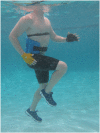Aquatic High Intensity Interval Training for Cardiometabolic Health: Benefits and Training Design
- PMID: 30202315
- PMCID: PMC6124844
- DOI: 10.1177/1559827615583640
Aquatic High Intensity Interval Training for Cardiometabolic Health: Benefits and Training Design
Abstract
High-intensity interval training (HIIT) has emerged as an attractive alternative to traditional continuous exercise training (CT) programs for clinical and healthy populations who find that they can achieve equal or greater fitness benefits in less time. Land-based HIIT may not be an appropriate choice for some participants. Few studies have explored the acute responses and chronic adaptations of HIIT in an aquatic environment, and no study has compared the cardiometabolic responses of an aquatic-based program to a land-based HIIT program. Shallow-water aquatic exercise (AE) programs utilizing HIIT have elicited comparable and, in some cases, greater physiological responses compared with constant-intensity or continuous AE regimens. Factors that may explain why HIIT routines evoke greater cardiometabolic responses than CT protocols may be based on the types of exercises and how they are cued to effectively manipulate hydrodynamic properties for greater intensities. Favorable aquatic HIIT protocols such as the S.W.E.A.T. system may serve as a beneficial alternative to land-based HIIT programs for clinical, and athletic populations, potentially reducing the likelihood of associated musculoskeletal and orthopedic complications. Hence, the purpose of this review is to examine the role of AE as an alternative safe and effective HIIT modality.
Keywords: HIIT; aquatic exercise; cardiometabolic training; water fitness.
Figures





Similar articles
-
Effects of aquatic high-intensity interval training and moderate-intensity continuous training on central hemodynamic parameters, endothelial function and aerobic fitness in inactive adults.J Exerc Sci Fit. 2022 Jul;20(3):256-262. doi: 10.1016/j.jesf.2022.04.004. Epub 2022 May 2. J Exerc Sci Fit. 2022. PMID: 35646132 Free PMC article.
-
The effect of home-based low-volume, high-intensity interval training on cardiorespiratory fitness, body composition and cardiometabolic health in women of normal body mass and those with overweight or obesity: protocol for a randomized controlled trial.BMC Sports Sci Med Rehabil. 2019 Dec 30;11:39. doi: 10.1186/s13102-019-0152-6. eCollection 2019. BMC Sports Sci Med Rehabil. 2019. PMID: 31893126 Free PMC article.
-
Effects of high intensity interval training on sustained reduction in cardiometabolic risk associated with overweight/obesity. A randomized trial.J Exerc Sci Fit. 2022 Apr;20(2):172-181. doi: 10.1016/j.jesf.2022.03.001. Epub 2022 Mar 19. J Exerc Sci Fit. 2022. PMID: 35401768 Free PMC article.
-
Is low-volume high-intensity interval training a time-efficient strategy to improve cardiometabolic health and body composition? A meta-analysis.Appl Physiol Nutr Metab. 2024 Mar 1;49(3):273-292. doi: 10.1139/apnm-2023-0329. Epub 2023 Nov 8. Appl Physiol Nutr Metab. 2024. PMID: 37939367 Review.
-
Guidelines for the delivery and monitoring of high intensity interval training in clinical populations.Prog Cardiovasc Dis. 2019 Mar-Apr;62(2):140-146. doi: 10.1016/j.pcad.2019.01.004. Epub 2019 Jan 24. Prog Cardiovasc Dis. 2019. PMID: 30685470 Review.
Cited by
-
Changes in Inflammatory Cytokines and Irisin in Response to High Intensity Swimming in Adolescent versus Adult Male Swimmers.Sports (Basel). 2020 Dec 1;8(12):157. doi: 10.3390/sports8120157. Sports (Basel). 2020. PMID: 33271764 Free PMC article.
-
Effects of aquatic high-intensity interval training and moderate-intensity continuous training on central hemodynamic parameters, endothelial function and aerobic fitness in inactive adults.J Exerc Sci Fit. 2022 Jul;20(3):256-262. doi: 10.1016/j.jesf.2022.04.004. Epub 2022 May 2. J Exerc Sci Fit. 2022. PMID: 35646132 Free PMC article.
-
Effects of High-Intensity Aquatic or Bicycling Training in Athletes with Unilateral Patellofemoral Pain Syndrome.Int J Environ Res Public Health. 2022 Apr 13;19(8):4675. doi: 10.3390/ijerph19084675. Int J Environ Res Public Health. 2022. PMID: 35457543 Free PMC article.
-
Aquatic high-intensity interval training (HIIT) may be similarly effective to land-based HIIT in improving exercise capacity in people with chronic conditions: a systematic review and meta-analysis.BMJ Open Sport Exerc Med. 2023 Nov 14;9(4):e001639. doi: 10.1136/bmjsem-2023-001639. eCollection 2023. BMJ Open Sport Exerc Med. 2023. PMID: 38022764 Free PMC article.
-
Effectiveness of Deep Water Running on Improving Cardiorespiratory Fitness, Physical Function and Quality of Life: A Systematic Review.Int J Environ Res Public Health. 2022 Aug 1;19(15):9434. doi: 10.3390/ijerph19159434. Int J Environ Res Public Health. 2022. PMID: 35954790 Free PMC article.
References
-
- American College of Sports Medicine. ACSM’s Guidelines for Exercise Testing and Prescription. 9th ed. Philadelphia, PA: Lippincott Williams & Wilkins; 2014.
-
- Campbell JA, D’Acquisto LJ, D’Acquisto DM, Cline MG. Metabolic and cardiovascular response to shallow water exercise in young and older women. Med Sci Sports Exerc. 2003;35:675-681. - PubMed
-
- Kessler HS, Sisson SB, Short KR. The potential for high-intensity interval training to reduce cardiometabolic disease risk. Sports Med. 2012;42:489-509. - PubMed
-
- Garber CE, Blissmer B, Deschenes MR, et al. American College of Sports Medicine position stand: quantity and quality of exercise for developing and maintaining cardiorespiratory, musculoskeletal, and neuromotor fitness in apparently healthy adults: guidance for prescribing exercise. Med Sci Sports Exerc. 2011;43:1334-1359. - PubMed
-
- Franklin BA. Preventing exercise-related cardiovascular events: is a medical examination more urgent for physical activity or inactivity? Circulation. 2014;129:1081-1084. - PubMed
Publication types
LinkOut - more resources
Full Text Sources
Other Literature Sources
